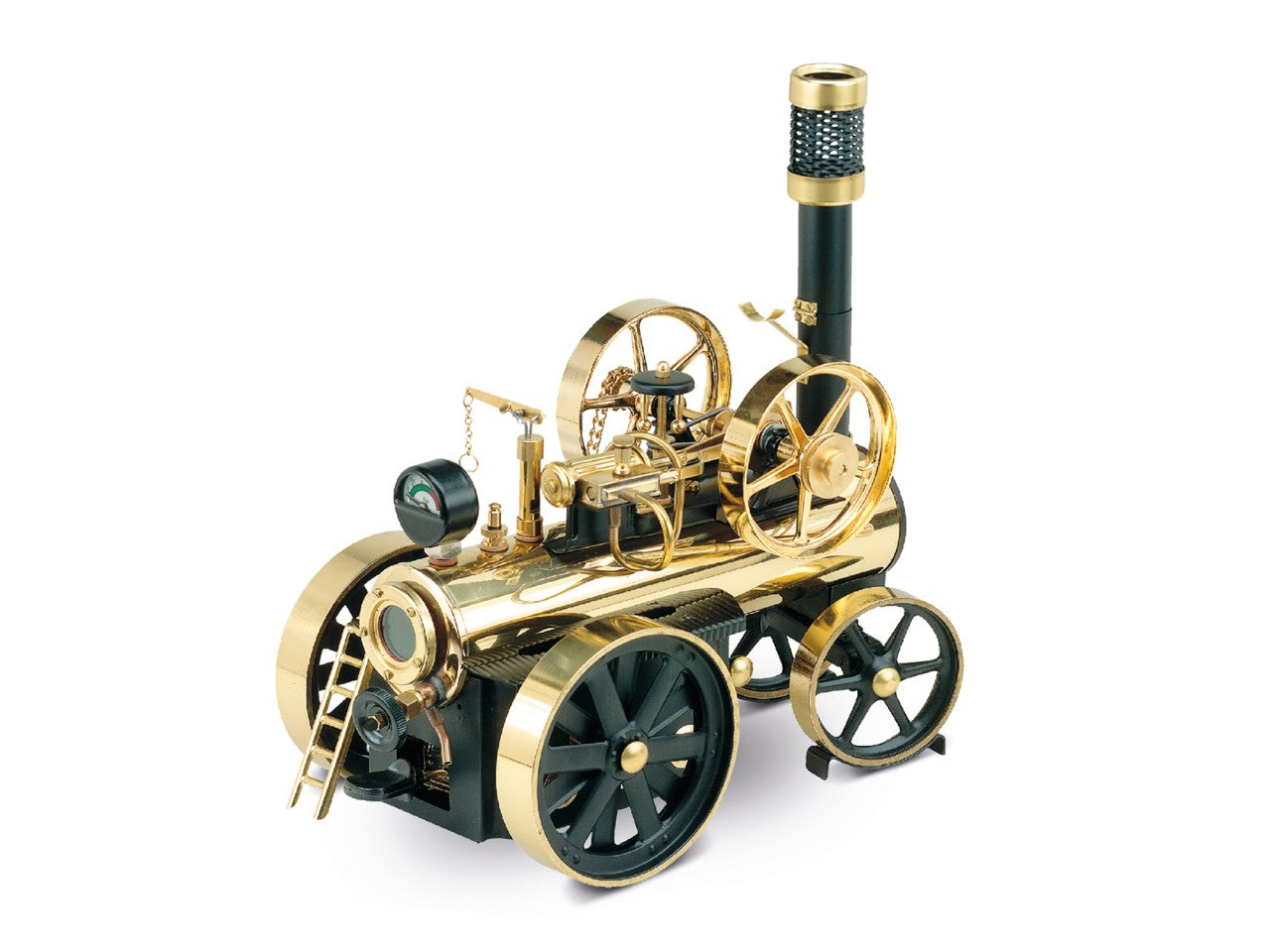
Steam traction engine D430
Pickup currently not available
The steam-powered traction engine D430 from Wilesco
At the turn of the 20th century, steam engines were primarily used in agriculture. They were used for plowing and threshing. At that time, steam engines could be mobile or stationary. They differed from automobiles in that they were often pulled to their destination by horses. However, they could also drive themselves and travel at speeds of 3-4 km/h. The details of the steam engine model D430 correspond to a common steam engine of the time. The brass boiler is 55 mm wide in diameter. It also has a separate smoke chamber for the condensate. This produces real steam from the chimney, which can also be tilted in the middle using a hinge. A special feature is that the cylinder is double-acting and equipped with two flywheels and a double drive pulley.
For your initial vaping pleasure, the D430 comes pre-loaded with two of our Witabs dry fuel. For longer vaping pleasure, please be sure to order sufficient dry fuel!
The exciting history of the Lokomobile
Locomobiles were primarily used by hired threshers. These could be thought of as a kind of agricultural day laborer. They traveled from farm to farm during harvest time, offering their services.
At that time, their traction engines could be mounted either in a mobile or stationary configuration. The difference from automobiles was that they were often pulled to their destination by horses. They could also drive themselves and travel at speeds of 3-4 km/h. Operation and power generation, however, were only possible while stationary.
Conveniently, even lower-quality fuel could be used to heat the steam engines. The firebox was even partially heated with straw or inexpensive wood. The steam engine built up a constant pressure and converted the heat into mechanical energy. A key advantage here was its low noise level. Internal combustion engines at the time caused considerable noise pollution, as their energy was generated through a series of explosions.
For heavy stationary work, traction engines were even used until the 1960s, primarily to power stone crushers or wood chippers. After that, they were largely replaced by tractors. These offered a more efficient cost-benefit ratio and were easier to operate.
Performance index
Performance Index 5
Base dimensions
further information
Spare parts
- 01848 Accessories complete in the bag
- 01643 Bearing block, small, 50x11x30 mm
- 01663 Boiler with spring safety valve including glass
- 01582 Burner slide 100 mm, brass
- 01619 Centrifugal regulator
- 01783 Complete unit
- 01759 Crank disc with bolt screw
- 01730 Cylinder complete, brass
- 01978 Cylinder cover
- 01935 Drive chain (57 links)
- 01462 Drive gear with axle
- 01889 Eccentric disc small
- 01688 Flywheel with axle 46 mm long
- 01689 Flywheel with axle 77 mm long
- 01718 Front wheel 70 mm
- 01916 Gear D18 mm, 10 teeth, bore 4 mm
- 01933 Gear D51 mm, 30 teeth, bore 4 mm
- 01934 Gear D51 mm, 30 teeth, bore 5 mm
- 01629 Grub screws for line rollers (1 bag = 10 pieces)
- 01595 Handwheel, loose, black
- 01637 Line roller / double line roller 25 mm brass bright
- 01628 Line roller, brass, D=14 mm
- 01545 Metal ring for water level glass D=27 mm (brass)
- 01876 Mounting cap for 4 mm axle, brass
- 01879 Mounting cap for 5 mm axle, brass
- 01502 Oiler attachment complete with screw M4, brass bare
- 01748 Piston connecting rod with screw
- 01745 Piston, diameter 9 mm
- 01528 Pressure gauge with bottom connection M 6, D=35 mm, including adapter piece 01529
- 01717 Rear wheel 100 mm
- 01520 Seals assortment M3 - M6
- 01743 Slide rod with screw, diameter 5 mm - from 1990
- 01750 Slider connecting rod with screw
- 01463 Small drive gear for flywheel axle
- 01664 Smoke chamber cover, double, front
- 01514 Spring safety valve, from 1990 M 6 x 0.75 fine thread, brass
- 01820 Steam pipe 2-part, brass
- 01594 Steam shut-off valve/drain valve without valve body - lower part, MS
- 01963 Steam whistle with chain pull, brass, M6 thread. When using steam whistles with chain pull, a spring valve must be installed on the boiler.
- 01720 Stopcock, brass with plastic lever
- 01988 Water drain valve with valve body lower part, drain pipe, collar nut/solder ring, brass
- 01573 fireplace, black










